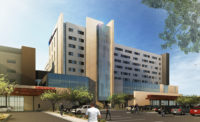ENR Southwest's 2014 Owner of the Year: City of Phoenix












As the largest and most diverse municipality in the Southwest, the city of Phoenix has pushed the boundaries of development and construction. As an owner, the city has worked with nearly every construction firm in the Southwest and has influenced scores of others with its drive to collaborate and streamline its construction processes.
The city's far-reaching influence includes acting as a permitter, developer and customer. But it is both the city's foresight and the depth of its projects that have earned Phoenix recognition as ENR Southwest's Owner of the Year. Industry firms say they clamor to work on jobs for the city, thanks to Phoenix's high level of professionalism and construction knowledge.
"I want the city of Phoenix to be a city of choice," says Wylie Bearup, city engineer. "I want us to be a public owner that good architects, engineers and contractors want to do work for—and to do that we need to have fair and open selection processes, we need to treat them fairly, we need to pay on time and we need to be consistent in our contract documents. All of that goes into my goal to make city of Phoenix an owner of choice."
Since 2006, Phoenix has donated land and $233 million in direct investment toward the development of the Arizona State University downtown campus. The next stage is the Sandra Day O'Connor College of Law, a $129-million, six-story building toward which the city has dedicated $12 million.
Nearby, the city has also been a major player in the decade-long development of the Phoenix Biomedical Campus, where it has crafted a public-private partnership with the University of Arizona, T-Gen and health care providers on the 28-acre, multi-building project that will total more than 6 million sq ft upon completion. The city donated the land for the Phoenix Biomedical Campus—which had originally been acquired for a National Football League stadium that never materialized—and provided a $63-million investment. Currently under construction is the University of Arizona Cancer Center, a $100-million facility.
Construction, engineering and design firms have praised the city's performance as an owner engaged in the entire design and construction process, whether the project scope is big or small.
"Each building the city successfully implements is an ambitious iconic architectural and community vision hinged upon absolute commitment with unyielding support from every project team member," says Peter Berg, design-build project executive with the Phoenix office of DPR Construction. The firm is currently working with the city on the creation and construction of the Phoenix Biomedical Campus.
Other contractors praised the city's fiscal discipline. "As owners of the largest design-build-operate water treatment plant in the Southwest with the Lake Pleasant Water Treatment Plant, [the city] established a new standard for public projects and demonstrated leadership in alternative delivery methods which save taxpayers millions of dollars and deliver better quality projects, faster," says Bo Calbert, president of McCarthy Building Cos.' Southwest division in Phoenix.
In addition to crafting a downtown educational and health care hub, the city has nearly $1.2 billion of capital improvement projects on the books. The city's three biggest capital investments—and the ones most closely associated with the construction industry—are streets, aviation and water.
Active Departments, Many Projects
Annual funding approaches $100 million to maintain and update the city's 4,849 miles of roads and 95,592 traffic signals. Bearup, also the director of the streets department and a driving force behind the Alliance of Construction Excellence, a collaborative industry group sponsored by the Ira A. Fulton Schools of Engineering at Arizona State University, says the city has its hands full with a plethora of city projects as the post-war city begins to show its age.
Since the city has both aging central areas and new development on the periphery, new construction, redevelopment and renovation are major points of emphasis. In downtown Phoenix, for example, most work is focused upon reconfiguring older systems, such as the recent construction of a downtown storm drain relief system.








